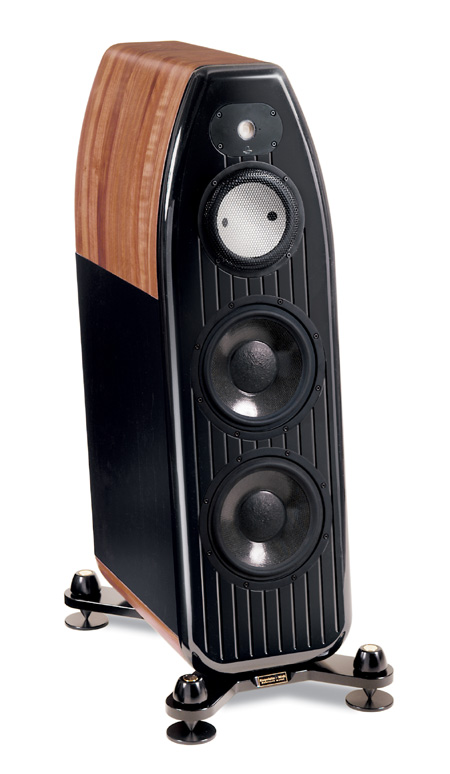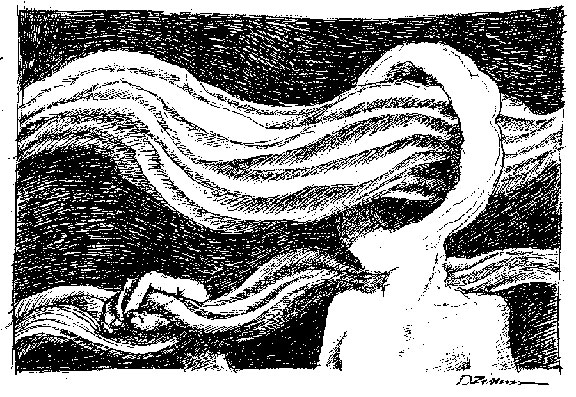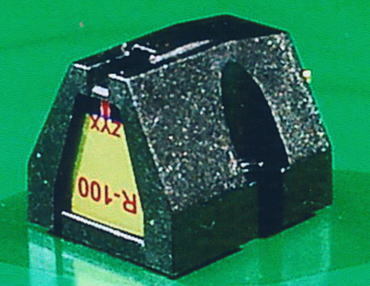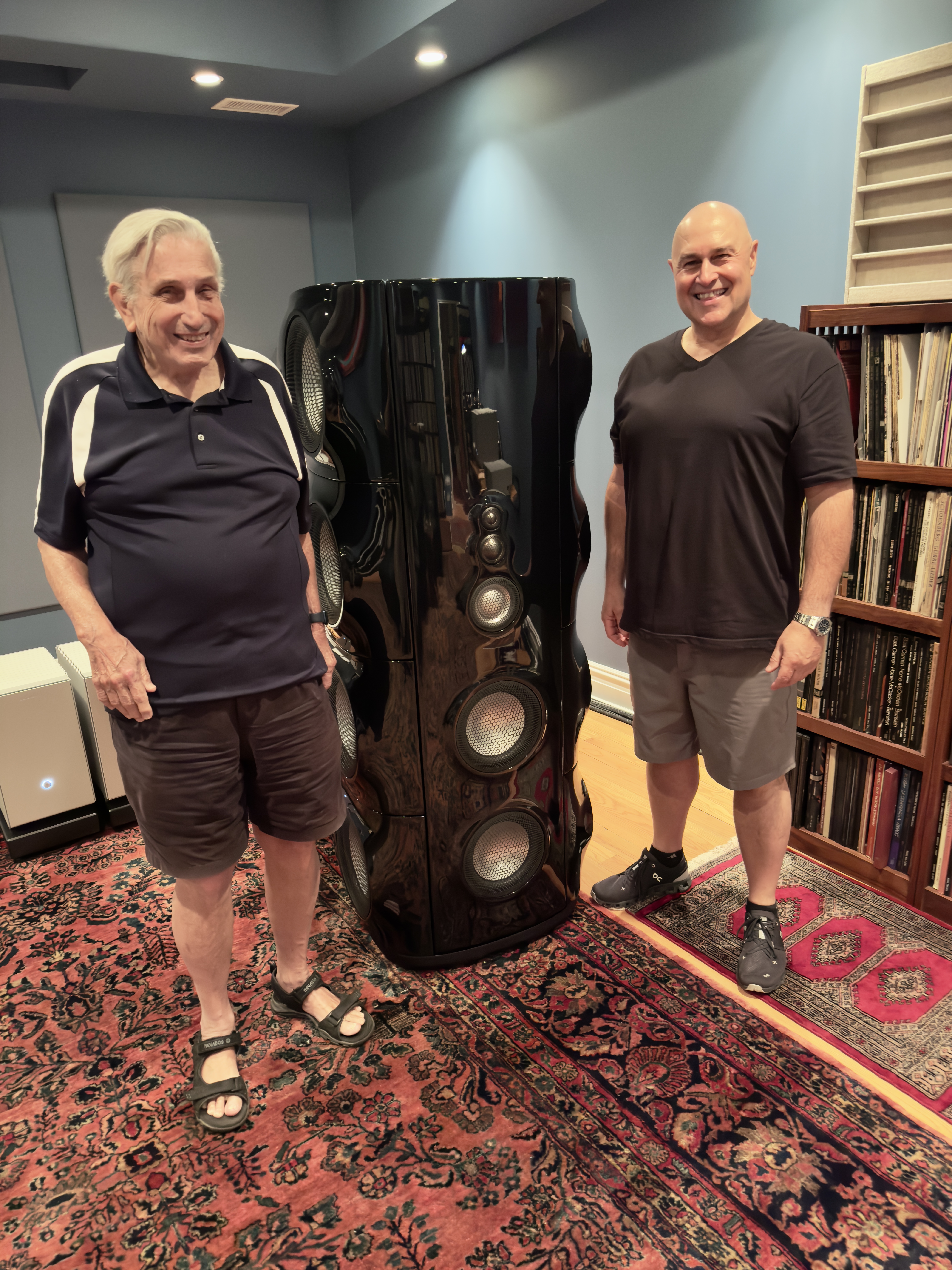This article, by Tom Davis, originally ran when Positive Feedback was in print - Vol. 6, No. 3, 1997.
Finding the Right Kind of Provocation
Little did I know that when I closed last issue's column with a promise to start responding to some of the speculations on High End aesthetics that have appeared in Positive Feedback, Harvey Rosenberg would be casting himself in that same issue as the catalyst for "a new form of dialogue within the Positive Feedback community." Great, Harvey! Let's got for it. PF's already well on the way to providing the kind of freewheeling art forum that could find its inspiration in Emerson's remark that "Truly speaking, it is not instruction, but provocation, that I can receive from another soul." Harvey's nothing if not a provocateur. And here "on the margins" I'm all for developing a genuinely critical aesthetic for the High End. So what would it mean to invite provocation as a freely given gift in an open and critical exchange of ideas? Just what kind of provocation does it take to encourage strangers to become friends in the pursuit of that very peculiar passion called the High End Audio? Well, let's try to find out. Let's experiment.
I want to critically respond to the techno-shaman ideal Harvey sketched as a way to provoke dialogue, and that response is going to lead me to consider the dynamic at work in the exchange between Herb Reichert and Stu McCreary over the roles of Medicine Men and Story Tellers in expanding the High End community. But first let me wrap up some unfinished business.
Final Marigo Comments
Last time I also promised some words of wisdom from Ron Hedrich about the theory behind his Marigo cable designs. Alas, despite some gentle arm twisting, Ron just won't give. He does, however, have a decent reason for his reticence, citing the misleading over-simplifications about cable design that have been recently appearing in print elsewhere. So instead of cable design, let me pass on some reflections I took away from a two hour meeting with Ron last October.
Ron is a designer with graduate work in physics and years of engineering work behind him, who knows how to measure up the yin-yang, but designs by ear. Meaning his heart is in his listening. I think we tend to underestimate how difficult it is to be true to your inner ear in all areas of the High End. But attentive listening begins with a power of discrimination that can't show up on an oscilloscope. Such discrimination grows from a sense of rightness or fittingness tuned into the claim of music and driven by a basic desire to explore the possibilities that claim opens up. But really exploring those possibilities takes something more.
A gifted designer works from a kind of double perspective: on one hand, physics and engineering have to inform "in principle" design decisions and empirical testing, but, on the other hand, everything turns on serving music. The different traditions of science and art don't have to shun each other, something their common Greek root in the word techne might clue us into. But other cultural inheritances that pit "head" against "heart" don't encourage the creative dialogue that's possible here. From talking with Ron, finding a route to that dialogue requires the right kind of working space, he calls it a "quiet mind," that can suspend the inherited prejudices of both these traditions to make way for just attentively listening in this moment. Such listening is quietly being present to whatever moves you in the work going on—or not going on—right now. Of the many different reasons for listening to your stereo, and of the many different "effects" it can promote, the quiet that allows you to attend to the work of art is, I take it, the foundation for whatever a High End aesthetic might aspire to.
So, yes, Ron could have started in on the design of his cables, and then found himself forced to go on and on trying not to oversimplify in too misleading a fashion. But what he'd rather do is encourage you to visit a dealer who allows home trials, and get his cable into your system for some "quiet mind" listening of your own (be sure to give the cable a day or so to "settle in" and be sure the dealer has run it in for at least 200 hours). And to remind you why I'm so enthusiastically willing to second this advice, let me make some final summary remarks on the difference Ron's best cables have made, using as an example Paul Simon's The Rhythm of the Saints.
The Rhythm of the Saints had a long production history trying to find the right place for Simon's voice in a recording of overwhelming rhythmic complexity. The problem was giving Simon's rather small, somewhat fragile voice the space it needed to carry off his lyrics, while still allowing the complexity to come through of the rhythms he had gone to such great lengths to weave in counterpoint to those lyrics. Ron's cables made two major differences in listening to this recording that I thought I knew very well, improvements that just kept improving as I moved from the Reference digital interconnects to the Signature analogue interconnects added two months later, and finally to the Signature speaker cables added six months after that.
The single most startling improvement was the openness of the clearing that now allowed musical lines and lyrics to emerge so much more gracefully than before. Expressive nuances in that rather small, somewhat fragile voice were now easier to follow because, with each cable addition, Simon's voice moved further into its own articulate space, and as that happened, the encompassing musical lines, especially the drum rhythms, were "re-arranged" in such a way that song after song came into more coherent focus. I now began to "read" the different narrative elements of these songs with an ease that encouraged me to listen again to discover more. This impulse to explore further was then encouraged by the internally related improvement in timbral signature.
Regardless of the striking improvements in digital, I still suffer the shock of recognition that comes when an instrument suddenly begins to sing clearly in its own voice. Discovering the range of expressive color in unfamiliar instruments should be one of the delights of a recording like The Rhythm of the Saints. Indeed it's clear that Simon challenged himself to find a way to bring rhythmically richer traditions and new possibilities of color into his own lyrical history in order to open new possibilities for song-writing. What I found myself better able to do with the complete Marigo re-cabling was progressively unfold the nuanced complexity of the mix of rhythm and color that Simon had woven into individual songs, and from there I've gotten hints about the kind of alternative world, or call it a meeting place for different traditions of music, that he wanted The Rhythm of the Saints to open. Being able to now explore this alternative world is what an audiophile system should enable you to do.
Final old business: I ended last time with an introduction to Audient Technologies' TACTIC pulse transformer and impedance matching network for digital cables. Well, I also mentioned at the beginning of my last column that there's been a lot of coming and going in audio journalism. Me included. So now I'm writing equipment reviews for Fi magazine, and I'm afraid you'll have to subscribe to find out just how good the TACTIC turned out to be. Let me, however, summarize what you can read for yourself in Fi #3: I bought it. Which, of course, only means that, yet again, you should experiment for yourself in your own system. My writing equipment reviews for Fi will mean less equipment talk in this column. And that means: more philosophy. Which seems fitting for an "Associate Editor/Aesthetics." So let's get to it.
Harvey's Techno-Shaman
I have to confess that I've only closely read a few chapters of Harvey's The Search for Musical Ecstasy. While I admire the verve with which he connects with aesthetic experience, I found myself put off by his overeager speculations about our evolution as a species, not to mention the latest rehash of his NYAL years. Of course it's often unclear where outrageous exuberance in living life to the fullest shades off into outrageously narcissistic self-posturing, though it is clear that Harvey enjoys pushing limits. And what better reason to read this magazine? So let's set aside the strengths and weaknesses of "Gizmo's" flamboyance, and just try to pay close attention to what Harvey wanted to push in asking last issue "Who Are We?"
"Who are we?" is the kind of question that can make all the difference in the world but usually proves too hot to handle. But again: aren't you reading this magazine precisely to push questions that might seem rather simple until you really listen to them? The more carefully you listen, the harder answering "Who are we?" becomes.
Harvey's answer is to point to an aspiration he calls "the audio artist as techno-shaman," defining a shaman as "the technician of the sacred," one who seeks "the mastery of ecstasy." Which sounds either cool or nutty depending on what you think music can do.
Harvey thinks music has replaced religion as the mediator of ecstasy in this culture. Or rather he thinks music reproduced at home has. So: "the priests in the temple of musical ecstasy are the solder slingers, the audio artists that we love." And to show just how powerful a product these priests produce, Harvey asks us to conduct a thought experiment. Imagine that "Dr. Zit, a mad scientist, has a switch, which when pulled turns off all the audio systems on the face of the earth. We watch on the television news a cultural meltdown more horrible than a nuclear holocaust."
What's wrong with this picture?
One problem with Harvey's thought experiment is that he envisions us still watching TV. Which betrays just how much the eye really does dominate the ear in this culture. Oh, I don't doubt that if his own audio system disappeared with a tug on Dr. Zit's switch, Harvey would, as he goes on to say, end up "sucking termites off the walls of a sanitarium." But then he badly underestimates the power of TV to keep the lid on cultural, socio-economic, and psychological discontent. All of us, and not just the growing permanent underclass in America, are pacified by the very same blue-glow-in-the-living-room that would supposedly reveal that "cultural meltdown more horrible than a nuclear holocaust." But Harvey not only forgot the power of the eye, he was also willing to ask us to imagine "holocaust" scale suffering in terms of the deprivation of reproduced music. Meaning, no doubt, that he also forgot to ask himself what it means that both the victims and their victimizers played Mozart in the horror of a different Holocaust. But then the ambiguities and ambivalence of following out that question might well clue us into the strangeness of the claim of music in this culture. And while I'm not ambitious enough to try to articulate the twists and turns of that strangeness here, even a momentary flash on strains of Mozart wafting through air laden with eternally falling ash might present us with a clue, however disturbing, to something else that's wrong with what I take to be the point of Harvey's thought experiment, something he is at least partially aware of.
As Harvey says,
Some would argue that the musician, or the music itself is the mysterious stuff [that gets turned off with the Zit-switch]. Alas, dear Yurok, [did he mean Yorick?], the musician, the composer, is composing for the home music experience; the success of zillions of dollars spent on ultra-high tech recording techniques are completely dependent and inseparable from the home music delivery system—our audio gizmos.
I'm, of course, one who would so argue. But first let's get straight on just how depressing Harvey's point is here. Why do composers compose? To creatively explore the claim of music? Well, no. They compose for the sake of the "home music experience." Really, Harvey? And all those zillions of dollars spent on recording techniques: just which composers are fixated on all that money? I mean which ones outside the "composers" of Top 40's tunes? Oh, I'm sure that there are a growing number of composers who experiment with different recording techniques, but again, aren't they so experimenting for the sake of the claim of music? And what would it mean to reduce the boundaries of that claim to the "home music experience"? After all, to repeat a question from the American composer Charles Ives that has become a favorite quotation of mine, "What does sound have to do with music?" Or to modify it here: What does recorded sound have to do with music? Or to push the point further: What do all those zillions of dollars spent on recording sound have to do with music?
Assuming we set aside Top 40s composers, I suspect that Harvey, like all too many audiophiles, has unconsciously mixed up composers and conductors/performers. Lots of conductors and performers do their thing for the sake of getting their recordings into homes. But one hopes they're more than hacks. Of course, the truly gifted are (just as are those transcendent artists that also happen to "make" the Top 40). For the heart of a gift for performance lies in the very same thing that claims the heart of a gift for composition: the life of the claim of music, the way music can take on a life of its own.
So, while I'm all for trying to articulate the unique possibilities that the claim of music presents in the "home music experience," and indeed I think that's exactly what a critical High End aesthetic calls for, I'm afraid that Harvey's techno-shamanist aspiration gets confused at a certain point about just what takes priority in undergoing an ecstatic claim. A shaman is a medium for the claim of something else, for that other transcendent life. The something else, not the medium, comes first. A point made crystal clear when the something else fails to make its claim, and the tribe gets a new shaman, not a new something else. Of course you can always claim that this "something else" is just a fiction created by the shaman to maintain his own power in the tribe. Or you can do a variation on this theme and parrot phrases like "the medium is the message" (i.e. become the medium and you are the message). But however much Harvey feels his "single-ended tubes and horns" pulse with animistic magic, and however significant his "Gizmo" nom de plume might prove to be, the history of music in the West is a long story of freeing the advent of one form of immanent transcendence from its cultic origins. Technique serves a claim that intrinsically transcends its own limits; that's how it's possible that the twelve-tone system could arise within the very musical tradition that it so radically called into question. But without getting into all the difficulties, most of which I don't yet understand, that arise at such a juncture in the history of music, let me end my consideration of what so struck me about Harvey's thought experiment in the following hopefully encouraging way.
The modern breakdown of any "dominant" tradition of music means that both the music we seek to inherit anew and music originally made can claim us in a good many different ways. But try a very simple one: Walk alone in a congenial place and ask your inner ear to work out a simple melody. Then extend this experiment, if possible, by coming home to your piano (or in my case, my mother-in-law's piano) to discover what variations this simple melody might suddenly evoke.
I'd encourage Harvey, indeed all audiophiles, to try this compositional exercise as a reminder about the nature of the claim of music. Playing around with a musical idea on my mother-in-law's piano, however banal I know it to be, there's a shift in perspective, a hint of just how autonomous the power of music might be, that helps me begin to listen to the possibilities hidden in that much neglected question, Who are we, we who call ourselves "audiophiles"? The life of an audiophile should be about finding yet another way for music to take on a life of its own. How might we encourage others to take up that kind of exuberance? To begin to get a sense for what's at issue here, let's consider part of the dynamic at work in the exchange between Stu and Herb.
Medicine Men and Story Tellers
The High End has always been a matter of living on the margins, but everyone knows those already slim margins are growing thinner. Something that follows, I think, from what I called "The Corey Effect" in issue 104 of The Abso!ute Sound. That article might well qualify for the kind of diagnostic effort that Stu would relegate to the "medicine men" of the tribe. Now I'm not sure how a "medicine man" is related to Harvey's techno-shaman, since the latter seems more hands-on oriented and the former more in-your-head. But then I'm not really interested in encouraging false dichotomies of any kind. Rather I'm interested in how the different folks in the High End, whatever their inclinations, can learn to learn from each other. How might we provoke each other in the right spirit of inquiry? How did Herb and Stu provoke each other in asking how best to promote the future of the High End?
What struck me about their exchange was the way certain values and interests seemed to insure a conflict between them. Stu thinks the Golden Tube SE-40 is a great way to invite more folks into the High End since it's both effective and cheap (at least by High End standards). Herb without directly mentioning it by name, but still dropping enough hints to let us know which amp he means, undercuts it as pandering to the lowest common denominator. Stu wants Herb to lighten up. Herb hopes Stu can be enlightened. And I suspect there's a point at which each will despair of the other's waking up. But why? Let's consider how a judgment gets passed here.
Now I can readily imagine that some, perhaps most, readers will think that I've passed judgment on Harvey's techno-shaman, if not on Harvey himself. What I've tried to do is take up Harvey's invitation to conduct a thought-experiment, and then show you where it led me. Then, in response, I offered an alternative thought-experiment and invited both Harvey and you to try it out to see where it could lead you. I think offering each other thought-experiments is a very sane way of pursuing questions like, "Who are we?" I also think it's a very useful way to set aside the premature urge to judge for the sake of trying to reconceive conflicts between bright, well-intended folks in the High End. Like Herb and Stu.
The clue to new a thought-experiment that both Herb and Stu could try out is in the notion of invitation itself. What I suspect is that Herb and Stu both know in their bones what it means to be invited into music. The seductive power of live music is the graceful ease with which one can be invited into its claim. How can we introduce such grace into our listening room? Perhaps asking this question by way of the following thought-experiment might allow Stu and Herb to rediscover their common concern.
Imagine a young professional who's been to a few rock concerts, danced to some live bands, yet mostly listened to CDs for background music on a mid-fi rack, but who's had one or two experiences with listening while driving long distance at night that suddenly surprised her with their power. This person doesn't see herself as an aspiring artist, but was touched by those singular experiences. Experiences that just don't seem to repeat themselves back home playing that same CD on the stereo. Why not? Why doesn't that invitation into the music come back? Now I realize this young professional might not exactly ask herself that question, but still she knows something's wrong. What would a good audiophile recommend she do?
Michael Fremer would sit her down and cue up the LP version of the disk that caught her by surprise on that long drive (assuming, assuming...). And Stu would then add those SE-40 amps. And Herb? Would he deny that such an addition would create a system that, to use his own words, "makes musical artistic expression more accessible" than her mid-fi rack? Well, no, of course not. But would Herb be satisfied with how the invitation into the music bloomed with those SE-40s? Well, no, of course not. But then why think Stu would be satisfied either?
The future of the High End depends on folks clueing into the way an audio system can invite them into exploring the claim of the music. But then just how far you can explore after accepting that opening invitation is a different question that calls for a different kind of thought experiment. One that involves its own set of grace-giving possibilities and peculiar conceptual confusions.
I'll take up this kind of thought experiment next time when I turn to a close look at Herb's other contribution to the last issue, his essay on meaning in music. And I plan to take that close look at "meaning in music" while exploring some music I mentioned last time, only this time I'll try to get its title right. Next issue I want to explore the meaning of what's claimed me in Patty Larkin's Stranger's World.

































